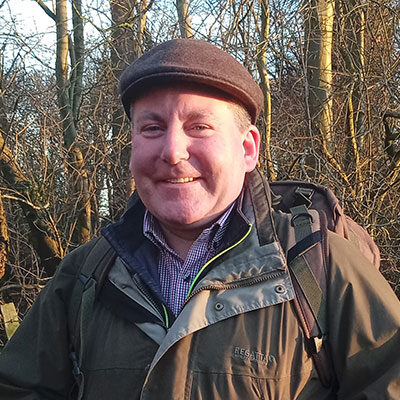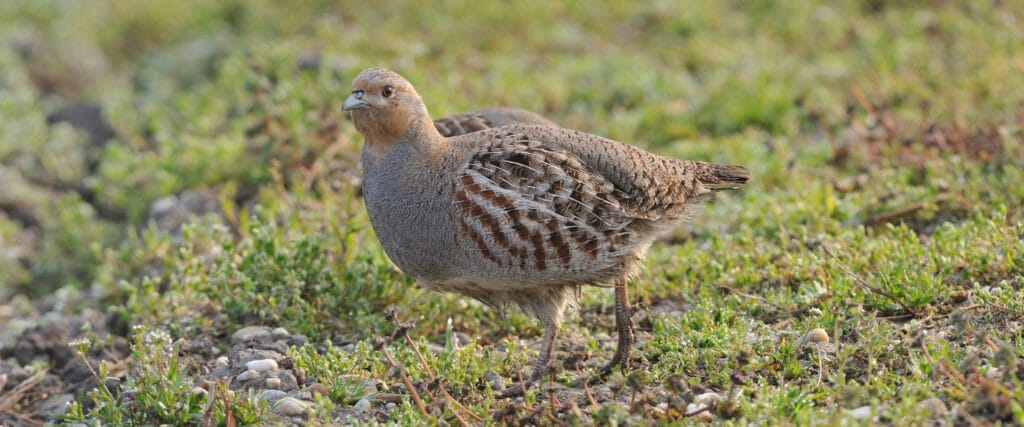Rewilding:
a fad or the future

Conor O'Gorman
From reintroducing sea eagles to returning gardens to nature, rewilding has captured the media’s imagination. Conor O’Gorman discusses what it means for shooting and conservation.
Making the rewilding case clear
Stodulky. Last stop on the Prague metro. On grassy wasteland, nearby the metro exit, I counted a covey of 22 wild grey partridges, unperturbed by the commuters and noise.
That cosmopolitan covey, 20 years ago, contained more partridges than had been seen in the previous six months by gamekeepers dedicated to helping the last wild grey partridge stronghold in the Irish midlands – a wild expanse of cutaway peatland spanning tens of thousands of hectares.
We will return later to the disparate fortunes of the partridges of Prague and Offaly, because their stories are intertwined and relevant to today’s rather convoluted rewilding debate.
The concept of rewilding was developed by academics in the 1960s within the context of preserving and expanding areas of wilderness that might otherwise see their large carnivores become extinct if such areas became too small and isolated.
That carnivore element helps explain why longstanding rewilding advocates push for reintroductions of bear, lynx and wolf. However, rewilders have frequently failed to make their case clear, nor have they meaningfully consulted those potentially impacted by such proposals.
Wild Ken Hill
The Ken Hill estate – or ‘Wild Ken Hill’, as it is now known – is located in an area of west Norfolk renowned for game shooting – and with Sandringham, no less, as a neighbour.
The estate recently hit the headlines when it announced a public consultation on proposals to release sea (white-tailed) eagles, a decade after a previous ill-fated bid by Natural England and the RSPB was shelved.
However, this time around the release of sea eagles looks to have some legs. The project is being led by local farmers and by the time of the public announcement the proposals already had the support of many of their neighbours, following an extensive low-key consultation.
An added factor is that sea eagles, originating from a reintroduction project on the Isle of Wight, have been regularly visiting Norfolk and no pigs have taken flight in the clutches of these flying fortresses of the bird world.
But there is much more to rewilding at Ken Hill estate than its now high-profile proposal to release sea eagles.
I have spoken several times with Dominic Buscall, who owns and manages the estate, and he is far from the stereotypical rewilder I originally had in mind. In fact, Dom is no stranger to shooting – as a student he was once listed as one of The Field’s top shots – although he is more focused on deer stalking these days.
Wild Ken Hill has sustainable walked-up wild grey partridge shooting and wildfowling and boasts a huge diversity of flora and fauna by combining rewilding, regenerative agriculture and traditional conservation across 4,000 acres.
Traditional conservation includes the management of 500 acres of freshwater marsh. Rewilding on the estate replaced the farming of unproductive land on sandy soils, allowing natural processes to return, improving biodiversity and capturing carbon.

A three-pronged system
Regenerative agriculture is targeted at productive arable land where the estate has adjusted its farming practices to repair soil health while delivering good, sustainable yields with minimal use of chemicals.
This three-pronged system is achieving a balanced approach to land use that the estate believes could be replicated on many other lowland farms.
The estate has also released beavers to help manage its wetlands, and natural grazing is aided by feral cattle, pigs and horses.
Dom explains: “We are passionate about what we can do for the environment and for society, but we are only at the beginning of a long journey. No doubt our project and our thinking will change as we adapt to the evolving challenges and opportunities around us.
“We are sharing our thoughts and information about our approach on our website and with visitors to the estate. We hope that by doing so we can become an exemplar in land management for lowland areas in the UK, and potentially beyond.”
When lockdown eases, the estate will introduce eco-tours and has its sights on camping for 2022, which will no doubt further widen its profile and appeal.
Kerry Ellis, BASC’s eastern England regional officer, has visited the estate and said: “I am hugely impressed with the variety of habitats found there. The benefits of this diversity to the wildlife can be seen throughout, from the abundance of yellowhammers and grey partridges to brown hares, marsh harriers and wildfowl of all shapes and sizes.
“When it comes to incorporating farming, conservation and sustainable shooting, the land managers at Ken Hill are clearly very forward thinking.”
Wild Ken Hill is part of a growing network of rewilding branded projects in Britain that is capturing the media’s imagination at a time when our post-Covid society is reconnecting with nature, and post-Brexit land management policies are promising to revolutionise farming for food and the environment.
Rewilding Britain
Rewilding Britain, founded in 2015, is a relatively new charity in the UK conservation world and has seen rapid growth, support and media interest through its collaboration with a network of land management projects. Its vision is to “see rewilding flourishing across Britain – reconnecting us with the natural world, sustaining communities and tackling the climate emergency and the extinction crisis”.
To celebrate World Rewilding Day (20 March) The Guardian featured several land and wildlife management projects in the UK, including Wild Ken Hill.
At Dundreggan in the Scottish Highlands, work is underway to expand the fragmented Caledonian Forest.
On the Somerleyton Estate in Suffolk, water buffalo roam wild and there are plans to bring in Dalmatian pelicans.
The focus is on less intensive land management and increased tourism at Wild Ennerdale in Cumbria, while The Tarras Valley Nature Reserve is a rebranding of Langholm moor in Dumfries and Galloway following a local community buyout, where peatland and woodland restoration will continue.
At Sheepdrove Organic Farm in Berkshire, the focus is on restoring chalk downland and wild meadows.
All the above case studies were described in The Guardian as rewilding projects, and they are part of the ‘rewilding network’.
A common theme I noticed across these and other conservation projects was the promotion of tourism. So, if eco-tourism is part of an estate’s income stream, rebranding the conservation work as rewilding makes good commercial sense in the current climate.
What does rewilding mean for shooting?
I don’t envisage shooting ever playing a flagship role in promotional material for rewilding projects, with perhaps the exception of deer stalking – which features on the evocative introduction video for ‘Wildland’, the network of Scottish estates being diversified by Danish billionaire Anders Holch Povlsen.
I think shooting will continue to be part of a wider diversity of activities taking place on many estates being rebranded as rewilding projects – both as a recreational activity and for estate employees and contractors undertaking pest and predator control.
Estates where shooting plays a central role in land and wildlife management, such as driven grouse moors and commercial pheasant shoots, will continue to have their place in the countryside. And, while biodiversity will continue to be high on these estates’ agenda, it’s unlikely that Rewilding Britain or the media would call them rewilding projects.
That said, the latest season of the popular computer game Fortnite has been ‘rewilded’ with the introduction of boar, wolves and other wild beasts; players can shoot them with guns and bows, eat their meat and utilise their bones. That’s millions of UK children being introduced online to hunting – food for thought!
Partridges in Prague and Offaly
So, what about those partridges in Prague and Offaly? Unfortunately, the Stodulky population boom was short-lived. Their temporary wildlands sprouted up during the development of a motorway and housing estates. The perfect unmanaged habitats that once gave food and shelter have long since become rank or concrete, and there is not a partridge to be seen.
However, in Offaly’s wild peatland landscape, where once a handful of partridges were clinging on, the birds are now thriving. This is thanks to the creation and management of wildlife corridors through the peatland and the introduction of partridge-friendly agri-environment schemes on previously inhospitable farmland.
Before researching this topic, my vague understanding of rewilding was a bunch of academics and keyboard warriors advocating abandoning large tracts of land and releasing various beasts into these ‘wildlands’.
Sure, those people and concepts exist, but rewilding in practice is more about estate managers seeking greater resilience through diverse and sustainable land management and income streams.
This article was originally published in the May/June edition of Shooting and Conservation magazine. Click here for more information on how to join BASC and receive your bi-monthly copy.
What do you think?
BASC is currently developing its position on rewilding and species re-introductions, and members views are very much appreciated in that process. To share your thoughts and experiences, please email Conor O’Gorman here.
Want to read more blogs?
Head to our Offbeat pages here.
